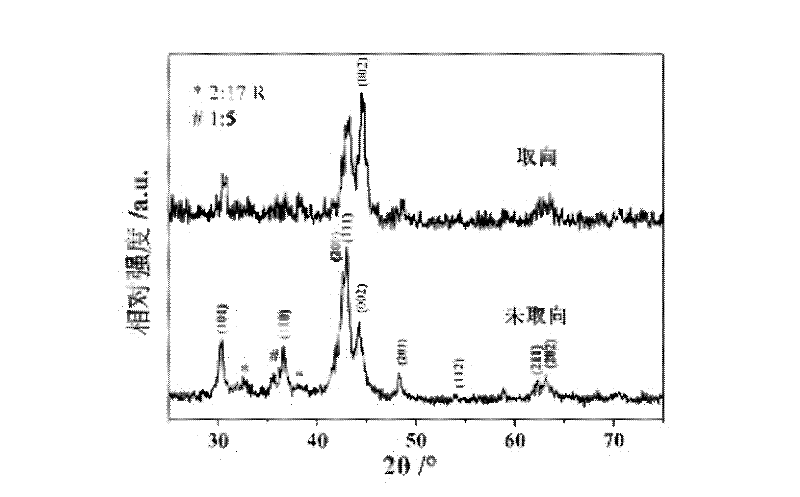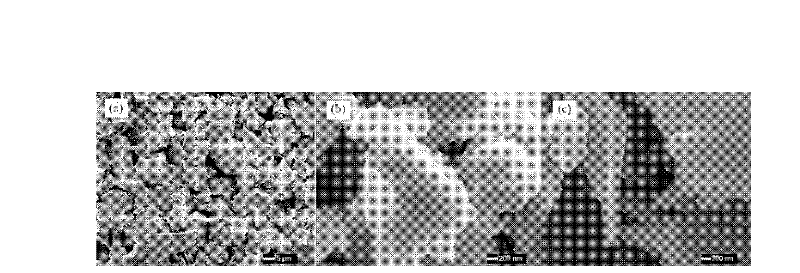Preparation method of anisotropic samarium cobalt-based nanocrystalline rare earth permanent magnet
A rare earth permanent magnet, anisotropic technology, used in permanent magnets, inductance/transformer/magnet manufacturing, electrical components, etc., can solve the problems of insufficient grain size, difficult to obtain anisotropy, and complicated operation.
- Summary
- Abstract
- Description
- Claims
- Application Information
AI Technical Summary
Problems solved by technology
Method used
Image
Examples
Embodiment 1
[0053] Anisotropic SmCo 6.6 Ti 0.4 Taking the preparation of nanocrystalline rare earth permanent magnets as an example, the specific steps are as follows:
[0054] Step A: prepare a master alloy of target composition.
[0055] According to SmCo 6.6 Ti 0.4 , a master alloy of the target composition was made with Sm with a purity of 99.95%, Co with a purity of 99.9%, and Ti with a purity of 99.9%. The total mass of the alloy is 30g, Sm 8.0770g (8.7232g with 8wt.% burning loss), Co2 0.8941g, Ti 1.0288g. Wherein the purity is the mass percentage purity.
[0056] Step B: Melting the ingot.
[0057] The SmCo prepared in step A 6.6 Ti 0.4 The master alloy is placed in the water-cooled copper crucible of the vacuum arc melting furnace, and the vacuum degree of the vacuum chamber is adjusted to 3×10 -3 Pa, then filled with high-purity argon to 0.5×10 5Pa; under the conditions of working voltage 40V and working current 700A, arc melting was carried out for 60s. After the allo...
Embodiment 2
[0070] Step A: prepare a master alloy of target composition.
[0071] According to SmCo 6.6 Ti 0.4 , with a purity of 99.95% Sm, 99.9% Co, and 99.9% Ti elemental elements to prepare a master alloy of the target composition. The total mass of the alloy is 40g, Sm 10.7694g (11.6310g with 8wt.% burning loss), Co27.8589g, Ti 1.3717g. Wherein the purity is the mass percentage purity.
[0072] Step B: Melting the ingot.
[0073] The SmCo prepared in step A 6.6 Ti 0.4 The master alloy is placed in the water-cooled copper crucible of the vacuum arc melting furnace, and the vacuum degree of the vacuum chamber is adjusted to 2×10 -3 Pa, then filled with high-purity argon to 0.2×10 5 Pa; Under the condition of working voltage 30V and working current 630A, the arc is smelted for 20s. After the alloy elements are completely melted, the arc is broken to form an alloy ingot; the alloy ingot is turned over and smelted 4 times repeatedly to obtain SmC with uniform composition. 6.6 Ti ...
Embodiment 3
[0086] Step A: prepare a master alloy of target composition.
[0087] According to SmCo 6.1 Si 0.9 , with a purity of 99.95% of Sm, 99.9% of Co, and 99.9% of Si elemental elements to prepare a master alloy of the target composition. The total mass of the alloy is 41g, Sm 11.5225g (12.3291g with 7wt.% burning loss), Co27.5488g, Si 1.9370g. Wherein the purity is the mass percentage purity.
[0088] Step B: Melting the ingot.
[0089] The SmCo prepared in step A 6.1 Si 0.9 The master alloy is placed in the water-cooled copper crucible of the vacuum arc melting furnace, and the vacuum degree of the vacuum chamber is adjusted to 4×10 -3 Pa, then filled with high-purity argon to 0.8×10 5 Pa; under the condition of working voltage 45V and working current 750A, the arc melting is 70s. After the alloying elements are completely melted, the arc is broken to form an alloy ingot; the alloy ingot is turned over and smelted 4 times repeatedly to obtain SmCo with uniform composition. ...
PUM
| Property | Measurement | Unit |
|---|---|---|
| Grain size | aaaaa | aaaaa |
| Particle size | aaaaa | aaaaa |
| Thickness | aaaaa | aaaaa |
Abstract
Description
Claims
Application Information
 Login to View More
Login to View More - R&D
- Intellectual Property
- Life Sciences
- Materials
- Tech Scout
- Unparalleled Data Quality
- Higher Quality Content
- 60% Fewer Hallucinations
Browse by: Latest US Patents, China's latest patents, Technical Efficacy Thesaurus, Application Domain, Technology Topic, Popular Technical Reports.
© 2025 PatSnap. All rights reserved.Legal|Privacy policy|Modern Slavery Act Transparency Statement|Sitemap|About US| Contact US: help@patsnap.com



